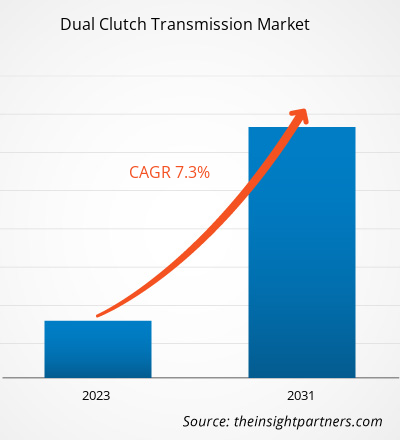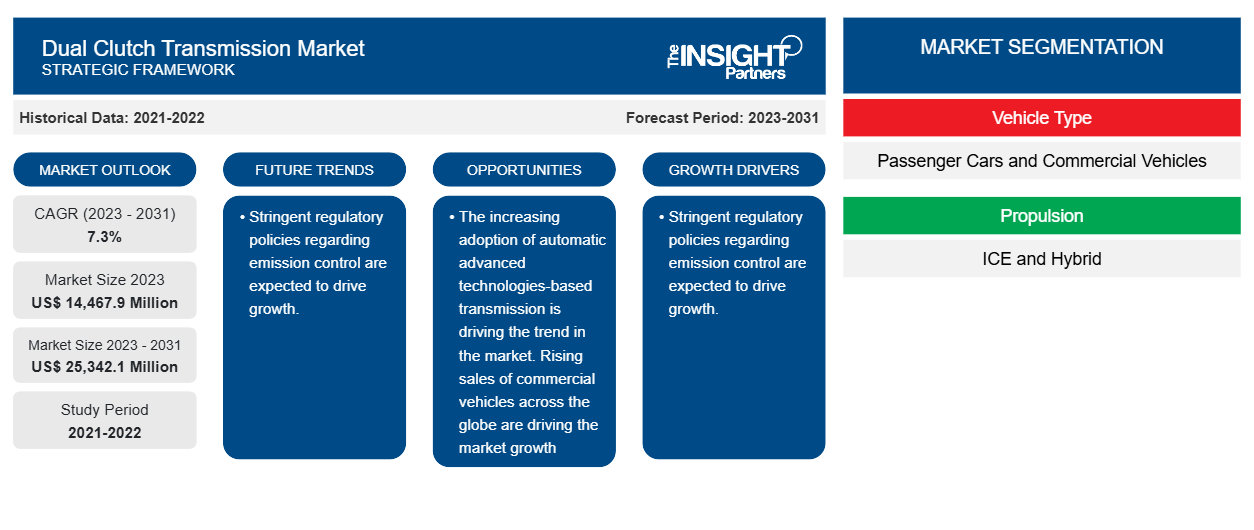Der Markt für Doppelkupplungsgetriebe soll von 14.467,9 Millionen US-Dollar im Jahr 2023 auf 25.342,1 Millionen US-Dollar im Jahr 2031 anwachsen. Der Markt soll zwischen 2023 und 2031 eine durchschnittliche jährliche Wachstumsrate (CAGR) von 7,3 % verzeichnen. Der Trend auf dem Markt wird durch die zunehmende Einführung automatischer Getriebe auf Basis fortschrittlicher Technologien vorangetrieben. Steigende Nutzfahrzeugverkäufe weltweit treiben das Marktwachstum voran.
Marktanalyse für Doppelkupplungsgetriebe
Der Markt für Doppelkupplungsgetriebe (DCT) wird vor allem durch die steigenden Verkäufe von Nutzfahrzeugen und Personenkraftwagen weltweit angetrieben. Die Nachfrage nach Doppelkupplungsgetrieben ist im asiatisch-pazifischen Raum am größten, da die Fahrzeugverkäufe in Indien, China und Japan steigen. Bei Personen- und Nutzfahrzeugen verwendet das Doppelkupplungsgetriebe eine automatische Kupplung, um die Kraftstoffeffizienz zu verbessern und eine hohe Leistung der Fahrzeuge zu bieten. Das Doppelkupplungsgetriebe verwendet zwei Kupplungsscheiben, die ein schnelles Schalten der Gänge ohne Eingangsverzögerung ermöglichen.DCT) market is majorly driven by increasing commercial and passenger vehicle sales across the globe. The demand for dual clutch transmission has the largest share in the Asia Pacific region owing to increasing sales of the vehicles in India, China and Japan. In passenger and commercial vehicles, the dual clutch transmission uses an automatic clutch to improve fuel efficiency and offer high performance of the vehicles. The dual clutch transmission uses two clutch plates that allow quick shifting of the gears without any input lag.
Marktübersicht für Doppelkupplungsgetriebe
Ein Doppelkupplungsgetriebe (DCT) ist ein automatisiertes Schaltgetriebe in Nutzfahrzeugen und Personenkraftwagen . Dieses Getriebesystem verwendet zwei Kupplungen zum Schalten von ungeraden und geraden Gangsätzen. Die Doppelkupplungsgetriebetechnologie bietet zwei Schaltgetriebe. Ein Pfad bietet den ersten, dritten, fünften und möglicherweise siebten Gang zum automatischen Schalten, während der andere gerade Gangstufen und den Rückwärtsgang bietet. Mit der zunehmenden Nachfrage nach verbesserter Kraftstoffeffizienz und Fahrzeugleistung wird die Doppelkupplungsgetriebetechnologie eingesetzt. Die Doppelkupplungsgetriebetechnologie bietet nahtlose Gangwechsel und effiziente Kraftverteilung für Nutzfahrzeuge und Personenkraftwagen.DCT) is an automated manual transmission in commercial and
Passen Sie diesen Bericht Ihren Anforderungen an
Sie erhalten kostenlos individuelle Anpassungen an jedem Bericht, einschließlich Teilen dieses Berichts oder einer Analyse auf Länderebene, eines Excel-Datenpakets sowie tolle Angebote und Rabatte für Start-ups und Universitäten.
-
Holen Sie sich die wichtigsten Markttrends aus diesem Bericht.Dieses KOSTENLOSE Beispiel umfasst eine Datenanalyse von Markttrends bis hin zu Schätzungen und Prognosen.
Markttreiber und Chancen für Doppelkupplungsgetriebe
Strenge Vorschriften zur Emissionskontrolle dürften das Wachstum vorantreiben.
In Nordamerika dürften Initiativen der Regierung, Bundespolitik und Programme für verschiedene Branchen den Markt für Elektrobusse ankurbeln. Die USA, Kanada und Mexiko haben das Handelsabkommen NAFTA unterzeichnet. Das Handelsabkommen half den Automobilherstellern bei der Erhöhung der Anzahl von Produktionsanlagen und der Verbesserung der Lieferkette für Autoteile. Die mexikanische Regierung legt großen Wert darauf, ausländische Direktinvestitionen anzuziehen , um den Fertigungssektor des Landes anzukurbeln. Automobilhersteller wie BMW, Audi und Mercedes investieren in das Land. Dies ist auf die verschiedenen Steuervorteile sowie die zollfreien Importe zurückzuführen, die die mexikanische Regierung anbietet. Darüber hinaus haben mehrere andere Automobilhersteller bereits eine Basis im Land.
Die Regierungen verschiedener Länder in der Region Asien-Pazifik konzentrieren sich auf die Automobilherstellung und ihr jeweiliges Land. Mit „Made in China in 2025“ unterstützt die chinesische Regierung beispielsweise lokale Unternehmen dabei, mit ausländischen Automobilherstellern und im globalen Wettbewerb zu konkurrieren. Darüber hinaus unterstützen Initiativen der indischen Regierung, wie der Automotive Mission Plan 2016–26, die wachsende Automobilindustrie des Landes. Daher würden diese Regierungsinitiativen das Wachstum des Automobilsektors in der Region fördern, was wiederum das Wachstum des Marktes für Doppelkupplungsgetriebe in der Region Asien-Pazifik unterstützen würde .
Die zunehmende Einführung von Kupplungssystemen auf Basis fortschrittlicher Technologie dürfte das Marktwachstum vorantreiben
Die wichtigsten Akteure auf dem Markt setzen auf fortschrittliche technologiebasierte Getriebesysteme, um neue Fahrzeugmodelle auf den Markt zu bringen. So brachte Stellantis N.V. im April 2024 in Italien ein elektrifiziertes Doppelkupplungsgetriebe auf den Markt. Das Unternehmen plante eine Investition von rund 260 Millionen US-Dollar für den Aufbau der italienischen Automobilindustrie im Mirafiori Automotive Park. Stellantis N.V. kündigte außerdem zusätzliche 108 Millionen US-Dollar an, um das Potenzial des Fiat 500e zu steigern. Eine solche Investitionssteigerung und der Beginn der Entwicklung der neuen DCT- Systeme durch die wichtigsten Akteure dürften reichlich Gelegenheit für Marktwachstum schaffen.
Segmentierungsanalyse des Marktberichts für Doppelkupplungsgetriebe
Wichtige Segmente, die zur Ableitung der Marktanalyse für Doppelkupplungsgetriebe beigetragen haben, sind Fahrzeugtyp, Antrieb, Fahrzeugklasse und Geografie.
- Basierend auf dem Fahrzeugtyp ist der Markt in Pkw und Nutzfahrzeuge unterteilt. Darunter hatten Pkw im Jahr 2023 den größten Anteil. Dies ist auf den steigenden Verkauf von Pkw weltweit zurückzuführen.
- Je nach Antrieb wird der Markt in Verbrennungsmotoren und Hybride unterteilt. Darunter hatte der Verbrennungsmotor im Jahr 2023 den größten Anteil. Dies ist auf die steigenden Fahrzeugverkäufe weltweit zurückzuführen. Laut der Internationalen Energieagentur stiegen die weltweiten Automobilverkäufe im Jahr 2022 auf 92,72 Millionen Einheiten, gegenüber 82,8 Millionen Einheiten im Jahr 2021.
- Je nach Fahrzeugklasse wird der Markt in A/B, C, D, E und höher sowie SUV und Vorwärtsgänge (6, 7 und 8 und höher) unterteilt. Unter diesen haben SUV den größten Anteil aufgrund der zunehmenden Einführung von DCT in SUV-Fahrzeugen.
Marktanteilsanalyse für Doppelkupplungsgetriebe nach geografischer Lage
Der geografische Umfang des Marktberichts für Doppelkupplungsgetriebe ist hauptsächlich in fünf Regionen unterteilt: Nordamerika, Asien-Pazifik, Europa, Naher Osten und Afrika sowie Süd- und Mittelamerika.
Der asiatisch-pazifische Raum dürfte aufgrund der gestiegenen Nachfrage und des Absatzes von Autos in Entwicklungsländern wie China, Indien und Japan den größten Anteil am Markt für Doppelkupplungsgetriebe haben. Laut der China Automotive Manufacturers Association wurden im Jahr 2023 in China rund 26 Millionen Pkw verkauft. Indien war der zweitgrößte Markt im asiatisch-pazifischen Raum. Diese Faktoren sind für das Wachstum des Marktes für Doppelkupplungsgetriebe im Prognosezeitraum verantwortlich.
Regionale Einblicke in den Markt für Doppelkupplungsgetriebe
Die regionalen Trends und Faktoren, die den Markt für Doppelkupplungsgetriebe im Prognosezeitraum beeinflussen, wurden von den Analysten von Insight Partners ausführlich erläutert. In diesem Abschnitt werden auch die Marktsegmente und die Geografie von Doppelkupplungsgetrieben in Nordamerika, Europa, im asiatisch-pazifischen Raum, im Nahen Osten und Afrika sowie in Süd- und Mittelamerika erörtert.

- Erhalten Sie regionale Daten zum Markt für Doppelkupplungsgetriebe
Umfang des Marktberichts zum Doppelkupplungsgetriebe
| Berichtsattribut | Details |
|---|---|
| Marktgröße im Jahr 2023 | 14.467,9 Millionen US-Dollar |
| Marktgröße bis 2031 | 25.342,1 Millionen US-Dollar |
| Globale CAGR (2023 - 2031) | 7,3 % |
| Historische Daten | 2021-2022 |
| Prognosezeitraum | 2023–2031 |
| Abgedeckte Segmente |
Nach Fahrzeugtyp
|
| Abgedeckte Regionen und Länder |
Nordamerika
|
| Marktführer und wichtige Unternehmensprofile |
|
Marktteilnehmerdichte: Der Einfluss auf die Geschäftsdynamik
Der Markt für Doppelkupplungsgetriebe wächst rasant, angetrieben durch die steigende Endverbrauchernachfrage aufgrund von Faktoren wie sich entwickelnden Verbraucherpräferenzen, technologischen Fortschritten und einem größeren Bewusstsein für die Vorteile des Produkts. Mit steigender Nachfrage erweitern Unternehmen ihr Angebot, entwickeln Innovationen, um die Bedürfnisse der Verbraucher zu erfüllen, und nutzen neue Trends, was das Marktwachstum weiter ankurbelt.
Die Marktteilnehmerdichte bezieht sich auf die Verteilung der Firmen oder Unternehmen, die in einem bestimmten Markt oder einer bestimmten Branche tätig sind. Sie gibt an, wie viele Wettbewerber (Marktteilnehmer) in einem bestimmten Marktraum im Verhältnis zu seiner Größe oder seinem gesamten Marktwert präsent sind.
Die wichtigsten auf dem Markt für Doppelkupplungsgetriebe tätigen Unternehmen sind:
- Magna International Inc. International Inc.
- Schaeffler Technologies AG & Co. KG
- BorgWarner Inc.
- Daimler AG
- Volkswagen AG
- ZF Friedrichshafen AG
Haftungsausschluss : Die oben aufgeführten Unternehmen sind nicht in einer bestimmten Reihenfolge aufgeführt.

- Überblick über die wichtigsten Akteure auf dem Markt für Doppelkupplungsgetriebe
Neuigkeiten und aktuelle Entwicklungen zum Markt für Doppelkupplungsgetriebe
Der Markt für Doppelkupplungsgetriebe wird durch die Erhebung qualitativer und quantitativer Daten nach Primär- und Sekundärforschung bewertet, die wichtige Unternehmensveröffentlichungen, Verbandsdaten und Datenbanken umfasst. Nachfolgend sind einige der Entwicklungen auf dem Markt für Doppelkupplungsgetriebe aufgeführt:
- Punch Powertrain bringt sein innovatives DCT-System mit einem revolutionären, kompakteren und erschwinglicheren Design auf den Markt. Der DT1 wurde in Indien eingeführt und debütierte bei der kürzlichen Markteinführung des Altroz DCA von Tata Motors. (Quelle: Unternehmenswebsite, März 2022)
- Tata AutoComp investiert 500 Crore Rupien in ein Werk für Doppelkupplungsgetriebe in Chakan. Mit dem Ziel, der wachsenden Nachfrage nach Autos mit Automatikgetriebe in Indien gerecht zu werden, strebt Tata AutoComp einen First-Mover-Vorteil an, während es ein neues Werk mit einer anfänglichen Produktionskapazität von 100.000 Einheiten vorbereitet. (Quelle: Pressemitteilung, Januar 2023)
Marktbericht zu Doppelkupplungsgetrieben – Abdeckung und Ergebnisse
Der Bericht „Marktgröße und Prognose für Doppelkupplungsgetriebe (2021–2031)“ bietet eine detaillierte Analyse des Marktes, die die folgenden Bereiche abdeckt:
- Marktgröße und Prognose für Doppelkupplungsgetriebe auf globaler, regionaler und Länderebene für alle wichtigen Marktsegmente, die im Rahmen des Berichts abgedeckt sind
- Markttrends für Doppelkupplungsgetriebe sowie Marktdynamik wie Treiber, Einschränkungen und wichtige Chancen
- Detaillierte PEST- und SWOT-Analyse
- Marktanalyse für Doppelkupplungsgetriebe mit Erfassung der wichtigsten Markttrends, globalen und regionalen Rahmenbedingungen, wichtigen Akteuren, Vorschriften und aktuellen Marktentwicklungen
- Branchenlandschaft und Wettbewerbsanalyse, einschließlich Marktkonzentration, Heatmap-Analyse, prominenten Akteuren und aktuellen Entwicklungen auf dem Markt für Doppelkupplungsgetriebe
- Detaillierte Firmenprofile
- Historische Analyse (2 Jahre), Basisjahr, Prognose (7 Jahre) mit CAGR
- PEST- und SWOT-Analyse
- Marktgröße Wert/Volumen – Global, Regional, Land
- Branchen- und Wettbewerbslandschaft
- Excel-Datensatz
Aktuelle Berichte
Erfahrungsberichte
Grund zum Kauf
- Fundierte Entscheidungsfindung
- Marktdynamik verstehen
- Wettbewerbsanalyse
- Kundeneinblicke
- Marktprognosen
- Risikominimierung
- Strategische Planung
- Investitionsbegründung
- Identifizierung neuer Märkte
- Verbesserung von Marketingstrategien
- Steigerung der Betriebseffizienz
- Anpassung an regulatorische Trends























 Kostenlose Probe anfordern für - Markt für Doppelkupplungsgetriebe
Kostenlose Probe anfordern für - Markt für Doppelkupplungsgetriebe